

Free: Download Thousands of Ottoman-Era Photographs That Have Been Digitized and Put Online. “Turkey is a geographical and cultural bridge between the east and the west,” writes Istanbul University’s Gönül Bakay.

This was so long before Constantinople became Istanbul, but after the rise of the Ottoman Empire, the region took on a particular significance for Christian Europe. “The Turk” became a threatening and exotic figure in the European imagination, “shaped by a considerable body of literature, stretching from Christopher Marlowe to Thomas Carlyle.” Images of Ottoman Turkey were long drawn from a “mixture of fact, fantasy and fear.”
With the advent of photography in the mid-nineteenth century, those images were supplemented, illustrated, and countered by prints depicting Turkish people both in everyday life circumstances and in Orientalist poses. The photos come from French collector Pierre de Gigord, who acquired them during his many travels through Turkey in the 1980s. Via Hyperallergic/The Getty Related Content: Josh Jones is a writer and musician based in Durham, NC. Portal de Archivos Españoles. El imperio de las cosas: un mundo de consumidores. Hay libros que llevan el sello distintivo del gran divulgador, libros que se venden bien en su mercado natural y que más temprano que tarde se traducen a otras lenguas.

ACHEMENET. Latest reviews. Columbia University. La misma bacteria provocó todas las epidemias posteriores a la peste negra. Una única cepa de la Yersinia pestis, la bacteria causante de la peste, está detrás de todas las epidemias de esta enfermedad que han castigado a los humanos desde la Edad Media.

La misma bacteria provocó todas las epidemias posteriores a la peste negra. 145 años de cerezas y barricadas: la banda sonora de la Comuna de París. La antigua Roma aún importa. A finales del siglo IV d.

Prof. Yuval Noah Harari - Official Site. Professor Emeritus, Medieval History, University of Kansas. Please take into consideration the purpose and audience for which the lecture notes listed above were written.
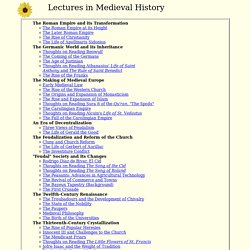
For a good many years, I taught a three-credit-hour freshman survey entitled Introduction to Medieval History to enrollments of room-size - generally three hundred students. Italian Renaissance Learning Resources - The National Gallery of Art. ‘The Bad-Ass Librarians of Timbuktu,’ by Joshua Hammer. Photo THE BAD-ASS LIBRARIANS OF TIMBUKTUAnd Their Race to Save the World’s Most Precious ManuscriptsBy Joshua Hammer278 pp.
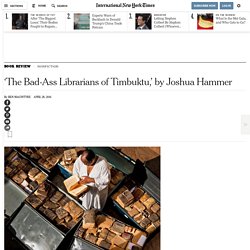
Simon & Schuster. $26. In the summer of 1826, a Scotsman named Alexander Gordon Laing became the first European to set foot in Timbuktu, a city that would become synonymous with mysterious remoteness. Smarthistory. art, history, conversation. Moorish Spain: A Successful Multicultural Paradise? Part 1. The Myth of the Andalusian Paradise:Muslims, Christians, and Jews under Islamic Rule in Medieval Spainby Dario Fernandez-Morera Wilmington: ISI Books, 2016 Dario Fernandez-Morera, of Cuban extraction, is associate professor of Spanish and Portuguese at Northwestern University.
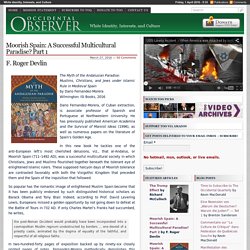
He has previously published American Academia and the Survival of Marxist Ideas (1996), as well as numerous papers on the literature of Spain’s Golden Age. In this new book he tackles one of the anti-European left’s most cherished delusions, viz., that al-Andalus, or Moorish Spain (711–1492 AD), was a successful multicultural society in which Christians, Jews and Muslims flourished together beneath the tolerant eye of enlightened Islamic rulers. Book: Guns, Germs and Steel. Fascinating.460 pages, ★★★★★ Guns, Germs and Steel does three things: It counteracts the misconception that “since the fifteenth century, enlightened Europeans have colonised simplistic New World natives”.

Historians and the surplus approach. An interesting feature of the literature in history, particularly when related to ancient history, is that ideas that are clearly in the tradition of classical political economy, that is the developments from William Petty to Marx including mainly, but not uniquely Quesnay, Smith and Ricardo, are often used in contrast with the dominant supply and demand approach of the literature in economics.
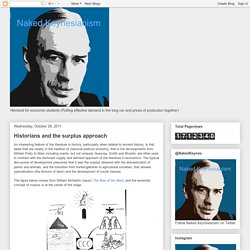
The typical discussion of development presumes that it was the surplus obtained with the domestication of plants and animals, and the transition from hunter/gatherer to agricultural societies, that allowed specialization (the division of labor) and the development of social classes. The figure below comes from William McNeill's classic The Rise of the West, and the essential concept of surplus is at the center of the stage. The deep causes of the Great Divergence: or why China fell behind. In the last post, I suggested that Kenneth Chase's explanation of why China invented, but did not pursue the development of gunpowder and guns to its ultimate consequences, could be seen as the very deep cause of the so-called Big Divergence, i.e. of the rise to dominance by Western Europe.
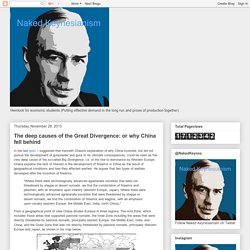
Chase explains the lack of interest in the development of firearms in China as the result of geographical conditions and how they affected warfare. He argues that two types of warfare developed after the invention of firearms. "Where there were technologically advanced agrarianate societies that were not threatened by steppe or desert nomads, we find the combination of firearms and pikemen, with an emphasis upon infantry (western Europe, Japan).
Where there were technologically advanced agrarianate societies that were threatened by steppe or desert nomads, we find the combination of firearms and wagons, with an emphasis upon cavalry (eastern Europe, the Middle East, India, north China). " How We Got to Now. Timothy May: The Mongol Empire in World History. World History and the Mongols An empire arose in the steppes of Mongolia in the thirteenth century that forever changed the map of the world, opened intercontinental trade, spawned new nations, changed the course of leadership in two religions, and impacted history indirectly in a myriad of other ways. At its height, the Mongol Empire was the largest contiguous empire in history, stretching from the Sea of Japan to the Carpathian Mountains. Power and Pathos: Bronze Sculpture of the Hellenistic World.
Power and Pathos: Bronze Sculpture of the Hellenistic World Italian fisherman recovered this statue from the Adriatic Sea in the 1960s. Commemorating a successful athlete, the figure stands in the conventional pose of a victor: he is about to remove his victory wreath of laurel or olive leaves and dedicate it to the gods in gratitude. His eyes were originally inset and his nipples are inlaid in copper, which would have appeared red in contrast to the once golden brown color of his bronze flesh.
Victorious Athlete ("The Getty Bronze") 300 - 100 BC; bronze and copper. The Homepage of the Circle of Ancient Iranian Studies (CAIS)© Sefarad Judíos en España Documental Completo en español ספרד, יהודים בספרד. Why the Mongols? The real question about the Mongols is, “Why did they win, and why did they win so big?” The Mongol empire is the great singularity in human history (though I’m sure that there are others in human prehistory): how did two or three million nomads — a nation without cities or writing — manage to conquer over half of Eurasia in less than a century?
Invasions and raids on wealthy states by their poorer neighbors are a historical constant, but nobody asks “Why the Petchenegs?” Or “Why the Xianbei?” , or “Why the Sarmatians?”. Genghis Khan’s Mongols are a real puzzle, like nothing that had ever been seen before. Rethinking the Social Structure of Ancient Eurasian Nomads: Current Anthropology Research : Nature.
First Posted: Feb 24, 2012 02:49 PM EST Rethinking the social structure of ancient Eurasian nomads: Current Anthropology research (Photo : Flickr.com/Lyalka) Prehistoric Eurasian nomads are commonly perceived as horse riding bandits who utilized their mobility and military skill to antagonize ancient civilizations such as the Chinese, Persians, and Greeks. Although some historical accounts may support this view, a new article by Dr. Michael Frachetti (Washington University, St. Louis) illustrates a considerably different image of prehistoric pastoralist societies and their impact on world civilizations more than 5000 years ago. Race May Be a Social Construct, But Racism is Very Real. “Race is a social construct.” I saw this sentence on the projector in my Race and Ethnic Relations class and jotted it into my notebook. Figuring that the statement was simply being used as an indication of how ridiculous and harmful racism is, I was on board with it.
I even used it in conversation a couple times. During a discussion in another course, a fellow student of color mockingly repeated the phrase, “Race is a social construct.” At first, I had to wonder why this phrase was worthy of mockery. Yes, race is socially constructed rather than biologically based. The ‘alarm’ is a reflex most minorities have, it’s a rising anxiety that signals you are surrounded by people too privileged to know they’re hurting you. El cerebro humano es una máquina hecha con piezas recicladas. La evolución actúa como MacGyver, un tipo capaz de construir artefactos con los que derrotar a un ejército aprovechando los adminículos que se pueden encontrar en una ferretería de pueblo.
Una pequeña edad de hielo pudo cambiar la historia de la Antigüedad. La plaga de Justiniano, la invasión de Europa por varios pueblos de las estepas, la caída del segundo imperio persa, la entrada de los turcos en Anatolia, la unión de los tres reinos de China, el inicio de la expansión árabe... Todos son eventos que tuvieron lugar entre el año 540 y el 660 de la Era Común. Ahora, un estudio de los árboles muestra que durante ese siglo y poco se produjo una edad de hielo donde la temperatura bajó hasta 4º en verano y aquel frío pudo ser el marco de tanta historia. En los últimos 2.000 años se han producido varias anomalías climáticas. Old trees reveal Late Antique Little Ice Age (LALIA) around 1,500 years ago. WSL dendroclimatologist Ulf Büntgen and his fellow researchers were able for the first time to precisely reconstruct the summer temperatures in central Asia for the past 2,000 years.
This was made possible by new tree-ring measurements from the Altai mountains in Russia. History of japan. The Ancient City Of Timbuktu (SECRET ANCIENT HISTORY DOCUMENTARY) Mansa Moussa, une des personnes les plus riches de l'histoire - Jessica Smith. Tenement Museum New York City - NYC Museum. Using Primary Sources - Teachers. Primary sources are the raw materials of history — original documents and objects which were created at the time under study. They are different from secondary sources, accounts or interpretations of events created by someone without firsthand experience. Examining primary sources gives students a powerful sense of history and the complexity of the past. Helping students analyze primary sources can also guide them toward higher-order thinking and better critical thinking and analysis skills.
Teacher's Guides and Analysis Tool. Raymond Bykes, Western Union No. 23, Norfolk Va. Said he was fourteen years old. Works until after one A.M. every night. He is precocious and not a little "tough." Has been here at this office for only three months, but he already knows the Red Light Dist. The Library of Congress does not own rights to material in its collections. Therefore, it does not license or charge permission fees for use of such material and cannot grant or deny permission to publish or otherwise distribute the material.
Ultimately, it is the researcher's obligation to assess copyright or other use restrictions and obtain permission from third parties when necessary before publishing or otherwise distributing materials found in the Library's collections. For information about reproducing, publishing, and citing material from this collection, as well as access to the original items, see: National Child Labor Committee (Lewis Hine Photographs) - Rights and Restrictions Information Rights assessment is your responsibility. More about Copyright and other Restrictions. The Great Inka Road: Engineering an Empire. Imperio de Mali, esplendor y decadencia: Timbuktu.
Who is a Turk : Origin of Turkic peoples. Genetic Origins of the proto Turkic Peoples and their Relatives National Geographics. The map as History. Explore the ancient world's great civilizations. Internet History Sourcebooks. Internet Modern History Sourcebook The Internet Modern History Sourcebook now contains thousands of sources and the previous index pages were so large that they were crashing many browsers.
Internet History Sourcebooks Project. East Asian History Sourcebook. Una masacre hace 10.000 años habla sobre el origen de la guerra. En verano de 2012, un equipo de paleoantropólogos se encontró en Kenia un escenario que dejaría helado a cualquier forense. Estaban cerca del lago Turkana, una zona clave para entender el origen del género humano, pues allí se hallaron los restos del Homo ergaster, nuestro ancestro. PEDAGOGÍA EN HISTORIA, GEOGRAFÍA Y ED. CÍVICA. UNIVERSIDAD DE LAS AMÉRICAS. VIÑA DEL MAR. año 2011. Ni los baños ni las letrinas públicas libraron a Roma de los parásitos. CrashCourse. AFRICAN KINGDOMS - Kingdoms of Ancient African History. Empire of Cotton by Sven Beckert. World History for Us All. «Negar que los musulmanes conquistaron la Península Ibérica es un disparate» La democracia según Karl Marx. Hans Rosling: The magic washing machine. Desmontando el ‘Mein Kampf’ (sin silenciarlo)
Despiadado Julio César. Rethinking Civilization - Crash Course World History 201. Tu perro surgió hace 33.000 años a partir de lobos del sur de China. El islam no es cosa de otros. BIZANTINOS, SASÁNIDAS Y MUSULMANES. EL FIN DEL MUNDO ANTIGUO Y EL INICIO DE LA EDAD MEDIA EN ORIENTE. 565-642. Kazajistán: La NASA ofrece más pruebas sobre los misteriosos ‘geoglifos de la estepa’
Cuando la humanidad migraba en masa hacia África. Retorno a la madre África. Renaissance and Reformation in Europe. MUNDO JAPON: El Periodo Edo -1º Parte- Educator Resources. History and Current Issues for the Classroom. History and Current Issues for the Classroom. 1000 to 1450: China. Emperor Justinian. 1/5 Los orígenes de la humanidad- La odisea de la especie. Watch Secrets of the Dead Online. Encyclopædia Iranica. Yuan Dynasty (1271–1368) Ukraine Separatists Rewrite History of 1930s Famine. Teaching the Middle East: A Resource for Educators. Capitalism and Socialism: Crash Course World History #33. Antigua Roma : Auge y Caída Del Imperio Romano - Capítulo 6 - La Caída de Roma (Español) Ancient Rome. Like Modern Civilization? Thank War. Biblioteca digital mundial. The map as History. 70 AÑOS DE LA MUERTE DE HITLER: De las cervecerías al búnker.
El franquismo, 40 años después. Nacionalismo: En el nombre de... Europa y Asia, 40.000 años divorciadas. Massive migration from the steppe was a source for Indo-European languages in Europe : Nature. Las lenguas indoeuropeas se propagaron sobre ruedas. Las lenguas indoeuropeas nacieron en Turquía. La peste llegó a Europa en oleadas desde Asia empujada por el clima. America Before Columbus.wmv. Armas Gérmenes Y Acero 1: Fuera del edén - 3 de 5. Armas Gérmenes Y Acero 1: Fuera del edén - 2 de 5. Armas Gérmenes Y Acero 1: Fuera del edén - 1 de 5. Art_5.pdf. Ciencia y tecnología para descifrar la historia. HSI: Historical Scene Investigation.